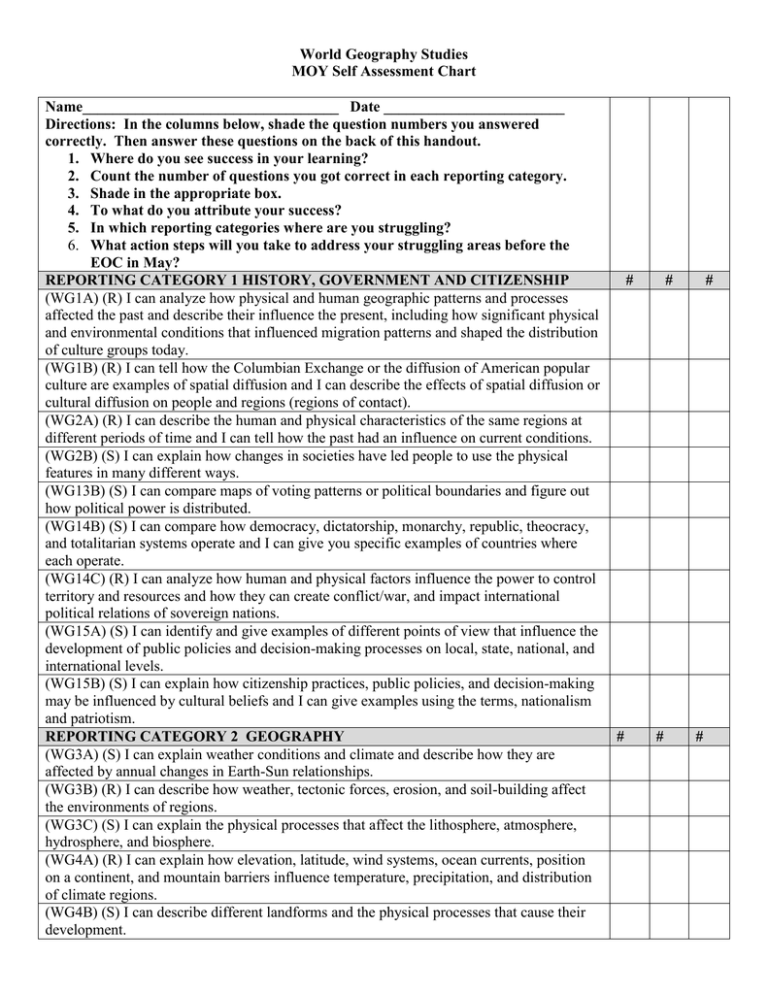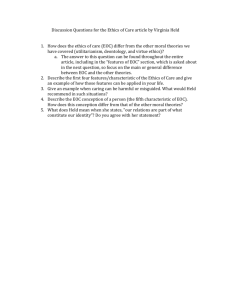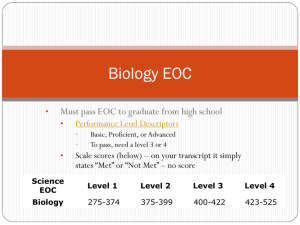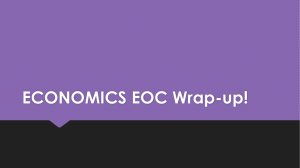2011-12 District MoY Student Self
advertisement

World Geography Studies MOY Self Assessment Chart Name__________________________________ Date ________________________ Directions: In the columns below, shade the question numbers you answered correctly. Then answer these questions on the back of this handout. 1. Where do you see success in your learning? 2. Count the number of questions you got correct in each reporting category. 3. Shade in the appropriate box. 4. To what do you attribute your success? 5. In which reporting categories where are you struggling? 6. What action steps will you take to address your struggling areas before the EOC in May? REPORTING CATEGORY 1 HISTORY, GOVERNMENT AND CITIZENSHIP (WG1A) (R) I can analyze how physical and human geographic patterns and processes affected the past and describe their influence the present, including how significant physical and environmental conditions that influenced migration patterns and shaped the distribution of culture groups today. (WG1B) (R) I can tell how the Columbian Exchange or the diffusion of American popular culture are examples of spatial diffusion and I can describe the effects of spatial diffusion or cultural diffusion on people and regions (regions of contact). (WG2A) (R) I can describe the human and physical characteristics of the same regions at different periods of time and I can tell how the past had an influence on current conditions. (WG2B) (S) I can explain how changes in societies have led people to use the physical features in many different ways. (WG13B) (S) I can compare maps of voting patterns or political boundaries and figure out how political power is distributed. (WG14B) (S) I can compare how democracy, dictatorship, monarchy, republic, theocracy, and totalitarian systems operate and I can give you specific examples of countries where each operate. (WG14C) (R) I can analyze how human and physical factors influence the power to control territory and resources and how they can create conflict/war, and impact international political relations of sovereign nations. (WG15A) (S) I can identify and give examples of different points of view that influence the development of public policies and decision-making processes on local, state, national, and international levels. (WG15B) (S) I can explain how citizenship practices, public policies, and decision-making may be influenced by cultural beliefs and I can give examples using the terms, nationalism and patriotism. REPORTING CATEGORY 2 GEOGRAPHY (WG3A) (S) I can explain weather conditions and climate and describe how they are affected by annual changes in Earth-Sun relationships. (WG3B) (R) I can describe how weather, tectonic forces, erosion, and soil-building affect the environments of regions. (WG3C) (S) I can explain the physical processes that affect the lithosphere, atmosphere, hydrosphere, and biosphere. (WG4A) (R) I can explain how elevation, latitude, wind systems, ocean currents, position on a continent, and mountain barriers influence temperature, precipitation, and distribution of climate regions. (WG4B) (S) I can describe different landforms and the physical processes that cause their development. # # # # # # (WG20B) (S) I can explain the economic, environmental, and social effects of technology such as medical advancements or changing trade patterns of societies at different levels of development. REPORTING CATEGORY 3 CULTURE (WG16A) (S) I can describe distinctive cultural patterns and landscapes associated with different places in Texas, the United States, and other regions of the world and how these patterns influenced the processes of innovation and diffusion. (WG16B) (R) I can describe elements of culture, including language, religion, beliefs and customs, institutions, and technologies. (WG16C) (S) I can explain ways various groups of people perceive the characteristics of their own and other cultures, places, and regions differently. (WG16D) (S) I can compare life in a variety of urban and rural areas in the world to evaluate political, economic, social, and environmental changes. (WG17A) (R) I can describe and compare patterns of culture such as language, religion, land use, education, and customs that make specific regions of the world distinctive. (WG17B) (S) I can describe major world religions, including animism, Buddhism, Christianity, Hinduism, Islam, Judaism, and Sikhism, and their spatial distribution. (WG17C) (S) I can compare economic, political, or social opportunities in different cultures for women, ethnic and religious minorities, and other underrepresented populations. (WG17D) (S) I can evaluate the experiences and contributions of diverse groups to multicultural societies. (WG18A) (R) I can analyze cultural changes in specific regions caused by migration, war, trade, innovations, and diffusion. (WG18B) (S) I can assess causes, effects, and perceptions of conflicts between groups of people, including modern genocides and terrorism. (WG18C) (S) I can identify examples of cultures that maintain traditional ways, including traditional economies. (WG18D) (S) I can evaluate the spread of cultural traits to find examples of cultural convergence and divergence such as the spread of democratic ideas, U.S.-based fast-food franchises, the English language, technology, or global sports. REPORTING CATEGROY 4 ECONOMICS, SCIENCE, TECHNOLOGY AND SOCIETY (WG10A) (S) I can describe the forces that determine the distribution of goods and services in free enterprise, socialist, and communist economic system. (WG10B) (S) I can classify where specific countries fall along the economic spectrum between free enterprise and communism. (WG10C) (R) I can compare the ways people satisfy their basic needs through the production of goods and services such as subsistence agriculture versus commercial agriculture or cottage industries versus commercial industries. (WG10D) (S) I can compare global trade patterns over time and examine the implication of globalization, including outsourcing and free trade zones. (WG11A) (S) I can understand the connections between levels of development and economic activities (primary, secondary, tertiary, and quaternary. (WG11B) (S) I can identify the factors affecting the location of different types of economic activities, including subsistence and commercial agriculture, manufacturing, and service industries. (WG11C) (R) I can assess how changes in climate, resources, and infrastructure (technology, transportation, and communication) affect the location and patterns of economic activities. (WG12A) (R) I can analyze how the creation, distribution, and management of key natural resources affects the location and patterns of movement of products, money and people. # # # # # # (WG12B) (S) I can evaluate the geographic and economic impact of policies related to the development, use and scarcity of natural resources such as regulations of water. (WG19A) (R) I can evaluate the significance of major technological innovations in the areas of transportation and energy that have been used to modify the physical environment. (WG19B) (S) I can analyze ways technological innovations such as air conditioning and desalinization have allowed humans to adapt to places. (WG19C) (R) I can examine the environmental, economic, and social impacts of advances in technology on agriculture and natural resources. (WG20A) (S) I can describe the impact of new information technologies such as the Internet, Global Positioning System (GPS), or Geographic Information Systems (GIS). (WG20B) (S) I can examine the economic, environmental, and social effects of technology such as medical advancements or changing trade patterns on societies at different levels of development. SKILLS/PROCESS STANDARDS – these are double coded with the content TEKS (WG13A) I can interpret maps to explain the division of land, including man-made and natural borders, into separate political units such as cities, states, or countries. (WG21A) I can analyze and evaluate the validity and utility of multiple sources of geographic information such as primary and secondary sources, aerial photographs, and maps. (WG21B) I can locate places of contemporary geopolitical significance on a map; and (WG21C) I can create and interpret different types of maps to answer geographic questions, infer relationships, and analyze change. (WG22C) I can use geographic terminology correctly. (WG23B) I can use case studies and GIS to identify contemporary challenges and to answer real-world questions. Self Analysis: Look at how you did in each reporting category. Count the number of correct answers in each category. Shade in the appropriate box based on the number you got correct. Between 0-8 right Between 9-13 right Reporting Category 1: History, Government, and Citizenship Looks like you struggled with this category. Go back and look at the learning goals in this category. Put a star by the 2 or 3 learning goals you want to master before the EOC. Look at the list of resources at the end and use some of them to review this content. Great job! You really know your stuff in this category. Concentrate on areas you struggle in first, then come back and do a quick review on this category right before the EOC. Between 0-14 right Reporting Category 2: Geography Looks like you struggled with this category. Go back and look at the learning goals in this category. Put a star by the 4 or 5 learning goals you want to master before the EOC. Look at the list of resources at the end and use some of them to review this content. Great job! You really know your stuff in this category. Concentrate on areas you struggle in first, then come back and do a quick review on this category right before the EOC. Between 15-23 right Between 0-7 right Reporting Category 3: Culture Looks like you struggled with this category. Go back and look at the learning goals in this category. Put a star by the 2 or 3 learning goals you want to master before the EOC. Look at the list of resources at the end and use some of them to review this content. Great job! You really know your stuff in this category. Concentrate on areas you struggle in first, then come back and do a quick review on this category right before the EOC. Between 8-12 right Between 0-7 right Reporting Category 4: Economics, Science and Technology Looks like you struggled with this category. Go back and look at the learning goals in this category. Put a star by the 2 or 3 learning goals you want to master before the EOC. Look at the list of resources at the end and use some of them to review this content. Great job! You really know your stuff in this category. Concentrate on areas you struggle in first, then come back and do a quick review on this category right before the EOC. Between 8-12 right BE SURE AND SPEND MOST OF YOUR TIME PREPARING FOR THE EOC IN THOSE CATEGORIES YOU STRUGGLED WITH Skills package GIS tutorial Talk it outs (test question analysis Review/Outlines per theme Reporting Category 2 Part 1: Physical Geography TEKS 3, 4, 8B, 9A Looping Cards for RC-2 Reporting Category 3: Culture Looping Cards for RC-3 Tutorial on Culture Reporting Category 1 History, Government and Citizenship Looping cards for RC-1 Jeopardy game for RC-1 Vocabulary for RC-1 Tutorial on Government Reporting Category 2 Part 2: Human Geography TEKS 5, 6, 7, 8A, 8C, 9A, 9B Looping cards for RC-2 Reporting Category 4: Economics, Science and Technology Looping Cards for RC-3 Please Note! Your particular campus resources go here!!! General Resources





